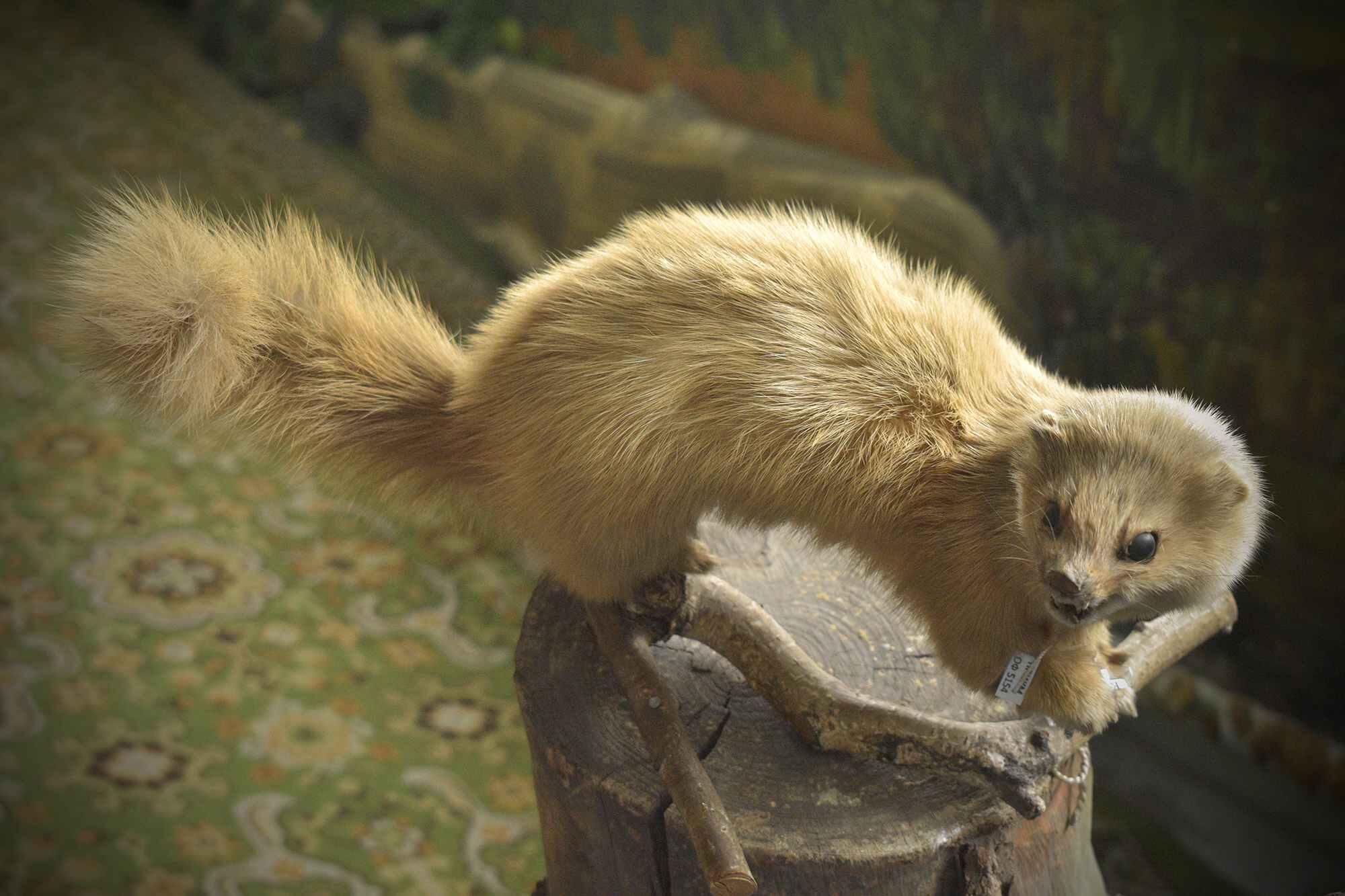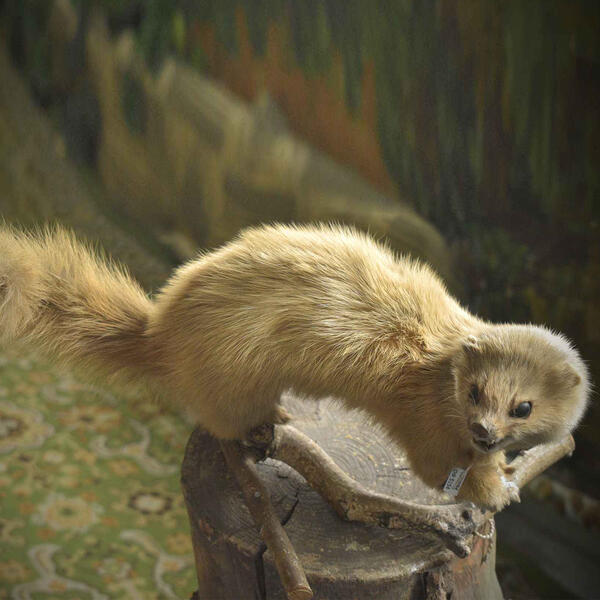The Siberian weasel is a fairly small carnivorous animal of the Mustelidae family. Its weight does not exceed 700 to 800 grams, and the length of its body together with the tail ranges from 48 to 66 centimeters. The Siberian weasel’s body is very flexible, elongated and nimble. The animal’s head is fairly small with a pointed snout chestnut in color. It is graced with white spots near its nose and what resembles a black mask around its expressive eyes. Its ears are quite small, tidy-looking and rounded in shape.
The Siberian weasel’s legs are short, with partially webbed feet. Its beautiful and bushy tail is this animal’s pride and joy. It reaches 18 to 20 centimeters in length. In winter, this mammal’s coat is orangish-yellow, while in summer time — orangish-red. Its fur is very thick and soft in winters. The molt occurs in March-May.
Siberian weasels prefer to inhabit coniferous or deciduous forests where a large number of rodents, its staple food, need to live. They like settling down on shores of water bodies, streams and rivers, especially if there are thickets of bushes growing on them. One can quite often come across these animals in various settlements, on the outskirts of towns and cities and near fields.
Siberian weasels stick to their territories. They often make burrows of chipmunks or voles, tree hollows and spots among fallen trees or brushwood their homes. When it is particularly cold, these animals can remain in their shelters for a number of days, and briefly hibernate in them. The mammals are mainly nocturnal creatures but in winters, they may also be active in the daytime.
Siberian weasels can travel up to 10 kilometers in search of food. It is a very inquisitive, agile and nimble animal. These predators can climb trees and rocks, and into crevices and tree hollows. They swim very well and can, in fact, swim out a considerable distance from the shore. Northern water voles, muskrats and river fish quite often become their prey. These animals also hunt small birds, such as sparrows, as well as larger ones, i.e. Eurasian capercaillie and hazel grouse, by stalking them under the snow. During seasons with an abundance of nuts and berries, they can eat those too.
An interesting and characteristic habit of the Siberian weasel is that regardless of where it finds the food, the animal always eats it only at home. The sounds that this mammal makes are similar to those of the European polecat. When irritated, these animals hiss in a whistling manner. They can also produce chirping and trilling sounds. Lynxes, foxes, wolves and European polecats hunt Siberian weasels, but their main enemies are sables. Birds of prey, such as hawks, owls, eagles and Eurasian eagle-owls, also pose a threat to these mammals.
This animal has a beautiful coat, which is widely used in the fur industry. Artists are also quite familiar with these creatures, as their fur is used to make soft paintbrushes, which are described as “Kolinsky”, based on the name of this animal in Russian, “kolonok”.
The Siberian weasel’s legs are short, with partially webbed feet. Its beautiful and bushy tail is this animal’s pride and joy. It reaches 18 to 20 centimeters in length. In winter, this mammal’s coat is orangish-yellow, while in summer time — orangish-red. Its fur is very thick and soft in winters. The molt occurs in March-May.
Siberian weasels prefer to inhabit coniferous or deciduous forests where a large number of rodents, its staple food, need to live. They like settling down on shores of water bodies, streams and rivers, especially if there are thickets of bushes growing on them. One can quite often come across these animals in various settlements, on the outskirts of towns and cities and near fields.
Siberian weasels stick to their territories. They often make burrows of chipmunks or voles, tree hollows and spots among fallen trees or brushwood their homes. When it is particularly cold, these animals can remain in their shelters for a number of days, and briefly hibernate in them. The mammals are mainly nocturnal creatures but in winters, they may also be active in the daytime.
Siberian weasels can travel up to 10 kilometers in search of food. It is a very inquisitive, agile and nimble animal. These predators can climb trees and rocks, and into crevices and tree hollows. They swim very well and can, in fact, swim out a considerable distance from the shore. Northern water voles, muskrats and river fish quite often become their prey. These animals also hunt small birds, such as sparrows, as well as larger ones, i.e. Eurasian capercaillie and hazel grouse, by stalking them under the snow. During seasons with an abundance of nuts and berries, they can eat those too.
An interesting and characteristic habit of the Siberian weasel is that regardless of where it finds the food, the animal always eats it only at home. The sounds that this mammal makes are similar to those of the European polecat. When irritated, these animals hiss in a whistling manner. They can also produce chirping and trilling sounds. Lynxes, foxes, wolves and European polecats hunt Siberian weasels, but their main enemies are sables. Birds of prey, such as hawks, owls, eagles and Eurasian eagle-owls, also pose a threat to these mammals.
This animal has a beautiful coat, which is widely used in the fur industry. Artists are also quite familiar with these creatures, as their fur is used to make soft paintbrushes, which are described as “Kolinsky”, based on the name of this animal in Russian, “kolonok”.



